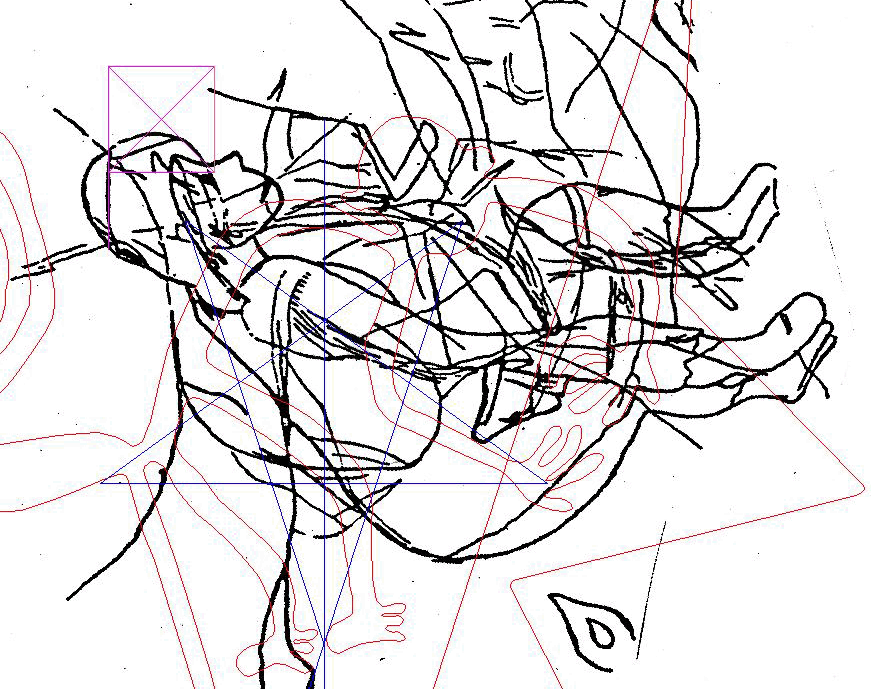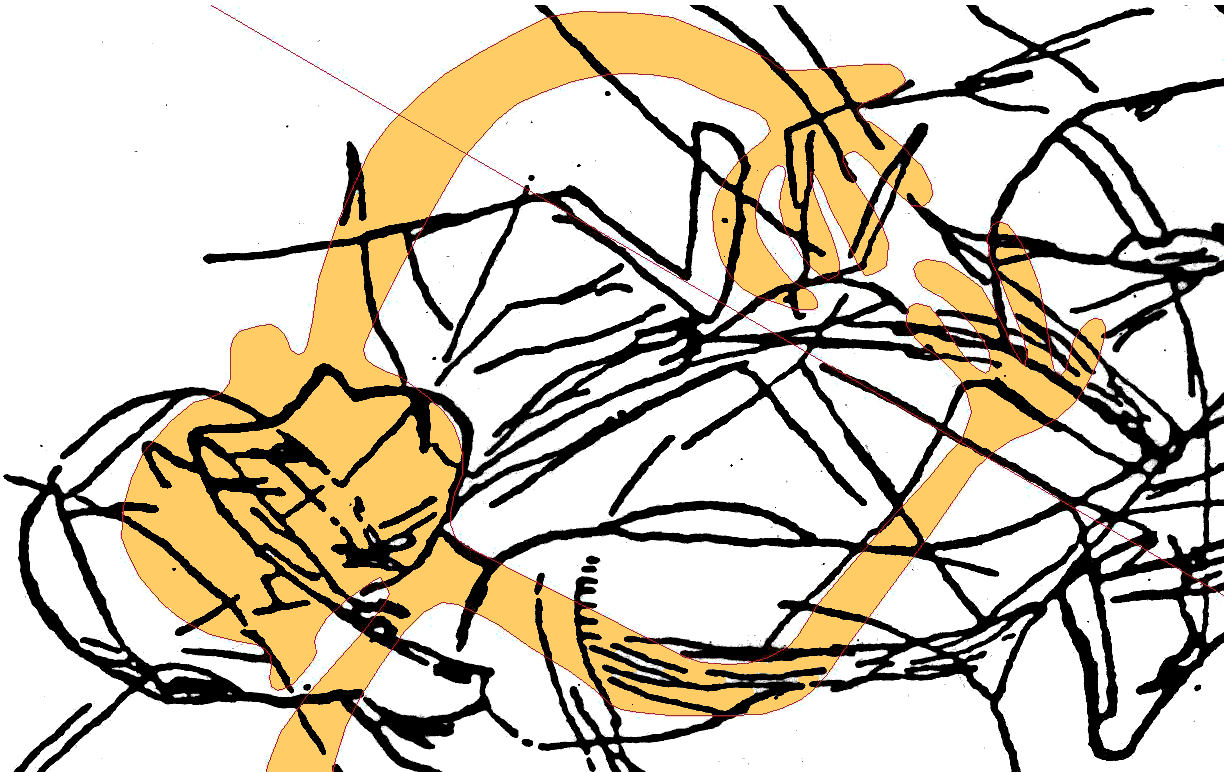Nazca Monkey's Global Connections
This chapter gives more examples on how one geometrical system unites three ancient
designs, each from a different continent and age. An unidentified prehistoric
agency (onwards
"Agency") has had global influence over our planet and created art and architecture
as mathematical puzzles for future generations:
We look at:
a) the
monkey figure from the world renowned Nazca Lines, Peru
b) a 14,000
years old engraving from
the not so well-known grotto of La Marche, France
c) the three
great Giza pyramids
The elements common to Athena and the monkey tend to lurk at a
different depth in each. When observing a given property in one work
which escapes notice in the other, going back to check for its presence
there often works out. The same is true about going back to these two
works with the Giza layout - it was a revellation. Therefore, the three
are best analyzed together.
Bringing the Giza layout into Athena reveals that the form of her head
depends on the Great Pyramid to a great degree, while also being
strongly influenced by the Second Pyramid. Overall, the entire Giza
plan is tightly integrated with the engraving.
Facing
the result, one symbolic meaning stands out - without any doubt, the
young woman from the engraving is being portrayed as having a
major role in
the design of the three big pyramids of Giza. Her role in the
implementation stage, however, remains an open question for the moment.
Otherwise, the pyramids would have to be at least
14,000
years old...
A star brings us together
The
ground plan of the three Giza pyramids sprawls almost one
kilometer from North to South; the monkey from Nazca spans
nigh a hundred meters,
while the
engraving from
La Marche tangles its lines over a portable A-4 sized stone
tablet. Each
of the three works (the engraving, the pyramids, the
monkey) had gone through being a 5-pointed star in its embryonic
stage; duly,
the three
can easily be scaled 1 : 1 : 1 by scaling the works
until their mother-stars become the same size. Next, superposing
the works so that their mother-stars fuse into a single star positions
them for proper comparison.
This idea is implemented in the image below. Out of the three Giza
pyramids only the Great Pyramid si shown, in order not to clutter the
view, The original
star is divided into left and right halves by
a central axis. Athena's head and the Great Pyramid are
to the left of that axis; the monkey's head is to the right, and is
away from the pyramid.
|

There
is some duality in view: The heads are at approximately the
same elevation, and a tip of the star is inserted in each
head.
Face Merging
These attributes are reflected across the stars vertical axis -
so, why don't we mirror the entire monkey across this axis to see what
happens?
The outcome is spectacular in that Athena's face is now almost
one-hundred percent inside the monkey's face, and her right eye
now doubles as the monkey's right eye!

The spiral tail looks quite well fitted to Athena's feet.
|

In the next experiment; without any rotation
whatsoever, we move
the monkey's head over the head of Athena to see how the two fit together.
A Perfect Fit
We
could not have hoped for a better result! It looks
like the Agency had built in confirmation of our scaling procedure. |

Monkey's 54 Degrees Counter-clockwise Rotation Around the Mother-star's Center

Except for a tiny sliver, Athena's face is once more completely contained in the monkey's head.
Its hands, esppecially the left one, are clearly attuned to the engraved lines of Athena.
The space around the star's center can be seen as a dial divided into multiples of 9 degrees - angles
created by the pentagram. In that case, a rotation of 54 degrees is one of the expected possibilities.
As well, the right side of the X-tree - both its straight part and the
triangles to the right relate to Athena's lines in a significant manner.
|


We already saw the above image in a different orientation. Here it is
oriented to the second most important element in the geometric system
of both the monkey and Athena - the Square. The system's name is "Cone & Square".
In the
illustration below, the Square is shown as a diamond. The lens inside the diamond is constructed from circles which
originate in the top and bottom corners of the Square.
Inside the lens we see the form of a pyramid; the image was reoriented to show the pyramid at the proper angle.
a) the monkey's head is inserted right over the pyramid's apex
b) the monkey's hands, especially the left one (once more), tune into Athena's lines.
The illustration is also suitable to pointing out the conceptual
difference between Athena and the
monkey in how they express the Square.. While both are seen to
have a considerable degree of harmony
with the Square, only Athena puts it into plain sight and
allows accurate derivation of its size, orientation, and
position. In contrast, the monkey conveys only the general
directions of
its diagonals. We cannot really see the square in the monkey on its
own. The square in the monkey results from a loop-back experiment -
copying the square in Athena & pasting it into the monkey's
mother-star. That's when we get to see its extraordinarily good fit
with the monkey.
|
Are any readers wondering at Athena's prone position? Shouldn't she be standing up just like the monkey?
I"ve always regarded the Athena engraving as a mandala, and
in this alternative orientation Athena can indeed be seen in an
upright stance. She is looking skywards, holding out the lens with the
pyramid inside. In my rendition, she is wearing a long,
tight fittting, yellow skirt, and a blue jacket. The scene's
symbolism is in agreement with the entire analysis. I'm not so sure
what to make of the fact that Athena also seems to be carrying the
monky on her back...
|

Mirroring the pyramids
Mirroring of the monkey across the star's central axis had given us
important insights. Why don't we try the same with the Giza plan?
The original construction chose one of two possibilities; let's look at
the other one, as well. This mirror image is seen below..
At this resolution, the overlapping second pyramid and its mirror-image appear as a single pyramid.
Of course, our main interest is in what happens between the Great
Pyramid's mirror image and the monkey's head:
* This pyramid is also partially inserted into the monkey's head.
*
The pyramid's axes are close to forming limits for the top and right sides of the head.
*
A diagonal of the pyramid divides the head into approximate halves.
*
The other diagonal looks close to being as wide as
the head.
|
|
|























